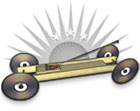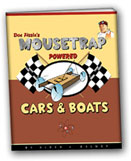Mousetrap Vehicles: Mechanical Advantage
Mechanical advantage is the ratio of the force put into a device and the force out. Learn all about mechanical advantage and how it applies to mousetrap racers.
The mechanical advantage is the ratio of the input and output forces that are used within a machine. An example of a simple machine is a lever. With a lever you have four important elements that you must identify: the applied force, the resultant force, the fulcrum, and the load. The applied force is put into the machine and the resultant force is what comes out of the machine. The load is what the machine is doing the work to and the fulcrum is where the lever pivots or rotates. A machine can be used to reduce the input force that is needed to lift an object. By changing the position of the applied force, load, and fulcrum of a lever the mechanical advantage of the system is changed.
Mechanical advantage is a measure of the force amplification achieved by using a tool, mechanical device or lever.
MA = Foutput / Finput
mechanical advantage: the mechanical advantage [MA] is equal to the output force divided by the input force. All forces are measured in newtons.
Levers
There are three classes of levers that are determined based on the position and direction of the applied force, resultant force, and the fulcrum. Pliers would be considered two connecting first-class levers. A wheelbarrow would be considered a second-class lever. A mousetrap would be considered a third-class lever. Like everything, you can not get something for anything and energy is no different when it comes to a machine. You can only get the same amount of energy out of a machine as you put into the machine. Any energy you put into a system is equal to the energy you get out of that system. With friction, some of the input energy is converted into heat and sound. Because of friction, some of the input energy is lost and the amount of energy that is actual used to do work determines the efficiency of the machine. Energy is the product of an applied force through a distance. With a lever, when one force is smaller than another force, the smaller force must travel a greater distance than the larger force so that the energy input on the system is equal to the output energy of the system. When the mechanical advantage is greater than 1, the input force (applied force) is smaller than the output force (resultant force) and the applied force is applied over a greater distance than the load's travel distance. When the mechanical advantage is less than 1, the input force is greater than the output force and the load travels a greater distance than the effort force's distance of travel.

Class 1 lever: The effort is applied on one side of the fulcrum and the resistance on the other side, for example, a crowbar or a pair of scissors or a seesaw.

Class 2 lever: The effort is applied on one side of the resistance and the fulcrum is located on the other side, for example, a wheelbarrow or a nutcracker.

Class 3 lever: The resistance is on one side of the effort and the fulcrum is located on the other side, for example, a pair of tweezers or the human mandible.

mouse trap: a mouse trap is an example of a third class lever.
Mechanical Advantage and Gears
The diameters of a drive wheel and the diameter of a drive axle represent the gearing and act as a transmission. A transmission is any device that transmits mechanical energy from one place to another. With a mouse trap car the energy of the mouse trap is transferred to the drive wheels through a transmission. In addition to getting energy from one place to another, the transmission can be used to change the torque and/or the pulling force.
Some of the common ways to transfer power to the drive wheels are direct drive, gear drive, belt drive, and friction drive. Not all are best used on a mouse-trap car.

types of transmission: a transmission is a way to transfer a torque and/or a force from one place to another. A transmission can also be used to change the mechanical advantage.
Gear and pulley ratios are used to describe the mechanical advantage. One gear or pulley is called the drive and the other the driven. The diameter or ratio of the drive and driven components of a transmission determines the force and speed that will result. Obviously, there are trade-offs that you need to understand. When a large gear or pulley is driven by a smaller gear or pulley, there is an increase in torque and a decrease in top speed. When a smaller gear or pulley is driven by a larger gear or pulley, there is a decrease in torque and an increase in top speed. Think of pedaling a multispeed bike. When the rear gear on a bike is as small as possible (i.e., it's in high gear), the bike can go the fastest on a level road, but as the road begins to slant upwards the bike begins to slow. More torque is required to propel the bike up the hill. By putting the bike into a lower gear, you increase the mechanical advantage of your gearing and consequently get more torque, but at the cost of less speed. It is important to match your transmission with the activity you need to perform. A Formula 1 race car and a tractor both have transmissions designed for the tasks they perform. A tractor needs more torque than a race car
MA = raxle / rwheel
ma of a drive wheel: the mechanical advantage [MA] is equal to the radius of the axle divided by the radius of the wheel.

a drive system: a drive wheel has a mechanical advantage that is equal to the radius of the axle divided by the radius of the wheel.
*Can't find what you're looking for? Ask Doc Fizzix »




